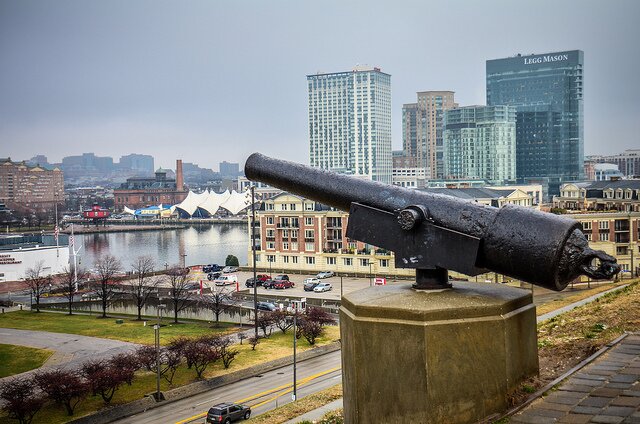Federal Hill is a neighborhood in Baltimore, Maryland, United States that lies just to the south of the city's central business district. Many of the structures are included in the Federal Hill Historic District, listed on the National Register of Historic Places in 1970. Other structures are included in the Federal Hill South Historic District, listed in 2003.
History
Early in the colonial period the area known as Federal Hill was the site of a paint pigment mining operation. The hill has several tunnels beneath its present parklike setting. On occasion a part of a tunnel will collapse causing the need to infill the area if the depression is near the surface of the edges of the hill.
From early in the history of the city, the hill was a public gathering place and civic treasure. The hill itself was given the name in 1789 after serving as the location for the end of a parade and a following civic celebration of the ratification of the new "Federal" constitution of the United States of America. For much of the early history of Baltimore, the hill was known as Signal Hill because it was home to a maritime observatory serving the merchant and shipping interests of the city by observing the sailing of ships up the Patapsco River and signalling their impending arrival to downtown businesspeople.
On the night of May 12, following the Baltimore riot of 1861, the hill was occupied in the middle of the night by a thousand Union troops and a battery under the command of General Benjamin F. Butler, who had entered the city, under cover of darkness and during a thunderstorm, from Annapolis via the Baltimore & Ohio Railroad. During the night, Butler and his men erected a small fort, with cannon pointing towards the central business district. Their goal was to guarantee the allegiance of the city and the state of Maryland to the Federal Government under threat of force. This fort and the Union occupation persisted for the duration of the Civil War. A large flag, a few cannons, and a small Grand Army of the Republic monument remain to testify to this period of the hill's history.
In the 20th century, Federal Hill was a working-class neighborhood, and by the late 1970s was yet another struggling Baltimore inner city neighborhood, with increasing crime, racial tension, depressed property values, and an aging and decaying housing stock. Many of the industrial jobs, particularly in the shipyards and factories along the south shore of the Patapsco River, which had long provided the main source of employment for neighborhood residents were in the process of disappearing. The Bethlehem Steel shipyards on the east side of the hill were one of the last to close, in the early 1980s. The nationally recognized urban homesteading program in nearby Otterbein, begun in 1975, helped spur interest among individuals and businesses in rehabilitating homes in Federal Hill, and it soon became a hotbed of investment and rehabilitation, particularly by young professional baby boomers who had grown up in the suburbs but worked downtown.
The investment and growth throughout downtown and especially at the Inner Harbor through the 1980s and 1990s only increased the popularity of Federal Hill living over the decades following the initial reinvestment period. A second period of intense investment and rising property values began in the mid 1990s. This second stage of neighborhood investment has included not just single-family home rehabilitation but increasingly large development projects on former industrial sites, particularly on the edges of the neighborhood around the water's edge. Within the core of the neighborhood itself, there has been an influx of new restaurants and shops. The city's population grew 0.6% in 2006 for the first time since the 1950s with much of the growth focused in Federal Hill. Streets that used to have vacant houses on every block have now been fully renovated. Many families have moved into these houses.
 Warren Ave, Baltimore, MD 21230
Warren Ave, Baltimore, MD 21230 6:00 am - 11:00 pm
6:00 am - 11:00 pm 410 396 6132What`s here?Natural beauty,
410 396 6132What`s here?Natural beauty, Video
Video






